Mississippi is an interesting state for mushrooms, because it is far enough south that it hosts a number of tropical and subtropical species that don’t grow in most of the US, plus other species that are common farther north. We’re not going to try to list all of them[i], but we will introduce you to a few of the more interesting species.
No, please do not take this list and run off to try to find dinner tonight—not if you’re a beginner. Identifying mushrooms is not quite as difficult as some writers would have you believe, but it’s not something you can learn on the internet in a day, either. There’s a bit of a learning curve. Here’s a taste, so to speak, to give you motivation to get up that curve.
If you do indeed go Mushroom Hunting make sure you have the proper tools, take a quality knife with you and a basket/bag for your haul!
This list is not meant to be used as a replacement for a field guide, spore prints, an identification app or an in person guide.
Our Recommended Field Guides for Mississippi
COVER | TITLE | Header | ||
|---|---|---|---|---|
OUR #1 RATED | ||||
Edible Mushrooms in Mississippi
Chanterelles and Trumpets






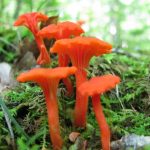



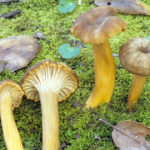



The Chanterelles and Trumpets are, together, a group of very distinctive-looking edible mushrooms that vary from good to excellent. They do have some poisonous look-alikes, but a little attention to detail will prevent mistakes. Generally, the chants are thicker-fleshed than the trumpets, and the two are separate but related genera, but some species have been moved back and forth between the two—there doesn’t seem to be a hard and fast morphological line.
Figuring out that something is a Chanterelle is easy. Look for a shape like the bell of a trumpet with ridges or veins rather than gills on the outside of the bell—there’s usually no clear distinction between cap and stem. Figuring out which chant you’ve got can be harder. The most popular type, the big and delicious Golden Chanterelle, is actually a large group of very similar species[ii]. It’s not clear which of these grows in Mississippi, only that one or more of them do. The Smooth Chanterelle (Cantharellus lateritius) is notable for having low ridges or none at all, but there are a lot of intermediate forms between this and several other species (including golden chants) that cause identification difficulties[iii]. The Small Chanterelle (Cantharellus minor) differs from the others largely in being very small, but golden chants can also sometimes grow small, so identification is only slightly easier[iv]. The Red Chanterelle (Cantharellus cinnabarinus) is at least not yellow—it’s a beautiful hot pink. But it does have a nearly identical look-alike in Texas and perhaps elsewhere[v].
As for the trumpets, there are various almost-identical black trumpets, but the one in Mississppi is almost certainly Craterellus fallax[vi]. The Yellowfoot, which is mostly yellow but often has a gray spore surface, is another species complex whose details are still being worked out[vii]. The Fragrant Chanterelle (Craterellus odoratus), which is actually a trumpet, is all-yellow and vase-shaped. Its identity is quite distinct, but it has a look-alike, leading to some confusion in the literature[viii].
Puffballs












Puffballs are ball-shaped mushrooms that entirely enclose the developing spores—at maturity, they either develop a single pore or simply rupture, releasing the spores. They are not closely related to each other. While many people say all puffballs are edible, that’s not really true. It’s just that people have a habit of deciding that ball-shaped inedible mushrooms aren’t real puffballs somehow. Still, many puffballs are edible, at least when young. It’s important to double-check the identity of any puffball headed for the table by slicing it vertically and looking at its interior. If the center is not entire homogeneous, it is not a puffball and could be very poisonous. If the center has begun to discolor or darken, the puff is too old to be eaten.
Mississippi has at least six edible puffballs. Four of these are in Lycoperdon genus: the Common (L. perlatum), Stump (L. pyriforme), Umber-Brown (L. umbrinum), and Peeling Puffballs (L. marginatum), and are similar in size and shape but different in color and surface texture. The other two, in the genus, Calvatia, are larger: the Purple-Spored (C. cyathiformis) and the Eastern Giant (C. gigantea) Puffballs.
Polypores
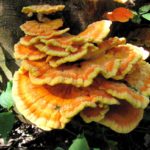







Polypores are shelf-shaped mushrooms, sometimes with a short stem on the side like a frying pan handle, sometimes without, that have pores rather than gills. They used to be lumped together in one genus but have since been separated. Most are tough and woody, but a few are good to eat.
Chicken-of-the-woods (Laetiporus sp.) is now known to be a group of mostly-yellow species that vary from mediocre (or even mildly toxic) to choice. Unfortunately, they are still often listed by their old name from when they were thought to be one species. Mississippi has at least two species, but it’s not clear which ones. Hen-of-the-woods (Grifola frondosa) does not resemble chicken-of-the-woods, but does look like a pile of gray chicken feathers. It tastes good cooked with cheese. Dryads Saddle (Polyporus squamosus) does look like something a large fairy might sit upon, and it’s good to eat when young—older specimens get too tough[ix]. Beefsteak polypore (Fistulina hepatica) does look like steak and even drips red fluid, but it can be eaten raw and tastes pleasingly sour[x].
Hericium sp.




The most famous member if this genus is Lion’s Mane (H. erinaceus), a club-shaped fungus covered in long, hair like spines that fruits from the wounds of tree trunks. It reportedly makes excellent vegetarian crab-cakes, and has some medicinal potential. Unfortunately, many writers treat all Hericiums as medicinally interchangeable, something for which there is no evidence, but they do at least taste similar. Mississippi’s other species is the Coral Tooth (C. coralloides), which has much shorter soft spines and is branched, rather like some corals.
Morels (Morchella sp.)
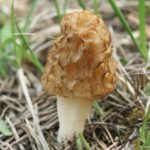







Morels are famously easy-to-recognize edible mushrooms—except they aren’t always safe to eat. Now and then, somebody eats properly cooked, properly identified morels and gets sick. And no one knows why. Morels ARE delicious, and usually they are fine, so the advice is simply to not eat a whole lot of them at once your first time. Also, while the group as a whole is easy to recognize, it’s often hard to tell just which morel you’ve got, as they vary a lot. Mississippi’s species are M. esculenta, M. americana, M. punctipes, & M. angusticeps.
Boletes
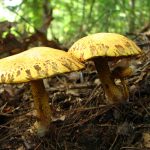



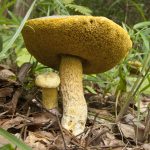















Boletes are all umbrella-shaped mushrooms with a flat surface full of pores rather than gills. They were once all classified in the same genus but are so no longer—in fact, some of them are being moved from one genus to another so often that we’re just going leave scientific names off of some of these. Not all boletes are safe to eat, but many are, and some are choice.
Mississippi has at least fifteen bolete species. None of these are actually poisonous, but several are entirely unpalatable. Of the others, the Chicken-Fat, Old-Man-of-the-Woods, Ornate-Stalked, Frost’s, and Peppery Boletes are variously borderline—some vary in flavor and are only good sometimes, while others are just not everybody’s cup of tea. The Pallid, Lilac, Slippery Jack, Chestnut, and Butterfoot Boletes are all much better.
Inky Caps










Inky caps, another group once categorized in one genus and since split up, are famous for two things: turning into black goo at maturity; and being delicious prior to turning into inky goo (the goo is edible, too, but it’s not really a mushroom anymore). Mississippi has at least four or five species. Common inky cap (Coprinopsis atramentaria) and possibly also Mica Cap (Coprinellus micaceus) interfere with the metabolism of alcohol, such that drinking alcohol within a few days of eating the mushroom will cause illness. Shaggy Mane (Coprinus comatus) is fine for eating with drink. Magpie Inky Cap (Coprinopsis picacea)[xi] is not good to eat at all—it’s toxic. And the Pleated Inky Cap (Parasola plicatilis)[xii] is debatably not a real inky cap, as it does not turn to inky goo. It’s not known to be edible, but it’s so small few people would want to try.
Wine Cap (Stropharia rugosoannulata)


The Wine Cap[xiii] is not only an interesting edible, it’s also a carnivore. The fungus supplements its diet of rotting plant matter by hunting nematode worms. The hunt happens in the soil at microscopic scales, so you can’t see it, but it’s still interesting to know about.
Our Recommended Field Guides for Mississippi
COVER | TITLE | Header | ||
|---|---|---|---|---|
OUR #1 RATED | ||||
Poisonous Mushrooms in Mississippi
There is no way to know if a mushroom is poisonous without identifying it to species and looking it up. Don’t believe anyone who says different; all the quick-and-easy rules of thumb have exceptions. It’s also not always easy to be sure something is poisonous even after you look it up, because there are species of unknown status, plus species that make some people sick but not others, and it’s not always clear why—when a mushroom is thus unclear, some experts decide to tell the public “it’s edible, just be careful,” while others say “it’s not edible,” and the result is quite confusing to the beginner.
The only solution is to learn as much as you can. Here’s a place to start learning. Bear in mind, there are poisonous mushrooms in Mississippi that didn’t make the list, so don’t assume something is edible just because we didn’t say it’s not!
Destroying Angel (Amanita bisporigera)


“Destroying angel” is the name of a number of closely-related, large, handsome, white or whitish species capable of killing a human eater. This one is Mississippi’s. All of them contain a potentially lethal dose of the same slow-acting, difficult-to-diagnose toxin. With prompt and proper treatment, some poisoning victims survive, but survival is by no means assured. Destroying angels are fairly distinctive-looking mushrooms, and yet it’s not uncommon for them to be mistaken for almost any species of gilled mushroom of similar color. Inattention to detail and wishful thinking can and do kill.
Deadly Galerina (Galerina marginata)


The Deadly Galerina contains the same toxin as the destroying angel, though they are not closely related. It’s a small, nondescript, brownish mushroom. Unfortunately, several popular edible species are also small, nondescript, and brownish—as are nearly all of the magic mushrooms. Worse, some of these desirable species share a habitat with the Deadly Galerina and can grow with it in mixed clumps. Every single mushroom headed for a human mouth must be properly identified first—every single one. No exceptions.
False Morels










The term “false morel” is applied to several vaguely morel-like species, mostly in the genus, Gyromitra. These are generally considered toxic (though not usually deadly), and yet people do eat Gyromitras on purpose, knowing what they are. The issue is that some people eat them with no ill effects—how likely illness is, and whether it’s possible to process these mushrooms to make them truly safe, are hotly debated matters. Mississippi has at least four species: G. esculenta, G. gigas, G. brunnea, G. caroliniana. Some members of several other genera are considered “false morels, such as Mississippi’s Helvella crispa. In all cases, the similarity to true morels is fairly superficial as true morels are pitted like honeycomb, and false morels are instead wrinkled.
False Parasol (Chlorophyllum molybdites)
The False Parasol, though not usually deadly, has the distinction of causing more cases of poisoning than any other mushroom species in America. Like the destroying angel, it is frequently mistaken for virtually any large, white or whitish edible mushroom, though its closest resemblance is to the shaggy parasol group. Its most distinctive characteristic is its green spores.
It’s worth noting that the shaggy parasol group, plus this species, actually all have some degree of toxicity and some potential for being eaten safely. This one simply occupies one end of the spectrum, the most commonly toxic of the group.
Earthballs (Scleroderma sp.)
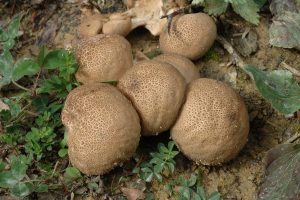



Earthballs are among several exceptions to the oft-repeated claim that puffballs are categorically edible. Some people will say that all “true” puffballs are edible, whereas this is a “false” puffball, but since the puffballs aren’t a taxonomically valid group, just some mushrooms that look vaguely similar to each other, any ball that puffs out its spores is a puffball. Earthballs aren’t even the only poison puff out there, though it seems to be the group most likely to be mistaken for the edibles. The key characteristic to pay attention to is that earthballs are firm, like rubber balls, while the small, edible puffs they most closely resemble are soft, like marshmallows. Earthballs also develop a dark interior much younger. Mississippi has at least two species, S. bovista and S. polyrhizum.
Jack O’Lantern Mushroom


Jack O’lanterns won’t kill you, but will make you very, very sick if you eat one. And you might, as they vaguely resemble golden chanterelles. Now, the resemblance is vague, since Jack O’lanterns have gills and chants have only ridges or veins, but the overall visual impression can be similar enough to cause confusion. Jack O’lanterns are also famous for glowing in the dark, but the glow is so faint many people can’t see it even under ideal conditions.
Our Recommended Field Guides for Mississippi
COVER | TITLE | Header | ||
|---|---|---|---|---|
OUR #1 RATED | ||||
Magic Mushrooms in Mississippi
Just to be clear, possession or use of “magic” mushrooms (those that contain psilocybin) is against both Federal and Mississippi law[xiv]. Since we don’t want out readers going to prison, we can’t recommend using these mushrooms—but some of them do grow wild in the state[xv].
Panaeolus sp.




Members of this group are often called Mottlegills or, simply, pans. Some species are not psychoactive at all, while others are extremely so, and everything in the middle. P. cinctulus is very widespread and is a sort of low middle in terms of potency. P. cyanescens is extremely potent and has been nicknamed “blue meanie” by enthusiasts—a name that also belongs to a cultivated strain of Psilocybe cubensis. The two should not be confused, nor should either be confused with the two Psilocybe species that are both called “Blue Foot.” These are all distinctly different mushrooms.
Psilocybe sp.




This is the genus made famous by the well-known psychoactive, P. cubensis, a tropical and subtropical species that is relatively easy to grow and is widely cultivated around the world. It grows wild in Mississippi, and is about in the middle in terms of potency. P. caerulescens is another species that likes a warm climate and finds it in Mississippi. It is slightly less potent.
References:
[i] (n.d.). Fungi and Lichens of Mississippi. iNaturalist
[ii] Kuo, M. (2015). Cantharellus “cibarius.” MushroomExpert
[iii] Kuo, M. (2015). Cantharellus lateritius. MushroomExpert
[iv] Kuo, M. (2015). Cantharellus minor. MushroomExpert
[v] Kuo, M. (2015). Cantharellus cinnabarinus. MushroomExpert
[vi] Kuo, M. (2015). Craterellus cornucopiodes. MushroomExpert
[vii] Kuo, M. (2015). Craterellus tubaeformis. MushroomExpert
[viii] Kuo, M. (2019). Craterellus odoratus. MushroomExpert
[ix] Bergo, A. (n.d.). Dryad’s Saddle or Pheasant Back Mushroom. Forager/Chef
[x] Bergo, A. (n.d.). The Beefsteak Mushroom. Forager/Chef
[xi] (n.d.). Coprinopsis picacea (Bull.) Redhead, Vilgalys & Moncalvo—Magpie Inkcap. First Nature
[xii] (n.d.). Parasola plicatilis (Bull.) Redhead, Vilgalys & Hopple—Pleated Inkcap. First Nature
[xiii] Pinzone, P. (2018). Fungi Friday; Stropharia rugosoannulata. Forest Floor Narrative
[xiv] (n.d.). Psychedelic Drug Laws in Mississippi. Tripsitter
[xv] (n.d.). Which Psilocybin Mushroom Grow Wild in My Area? Shroomery






Not one of the mushrooms that grow in our yard are pictured in your article. The Wine Cap is close to one of ours, but the one we have is bright red. Thankfully our dogs leave all the varieties alone, but I would still like to know what they are.
This is just an introductory article. I suggest you grab the field guides I recommend here for Mississippi.